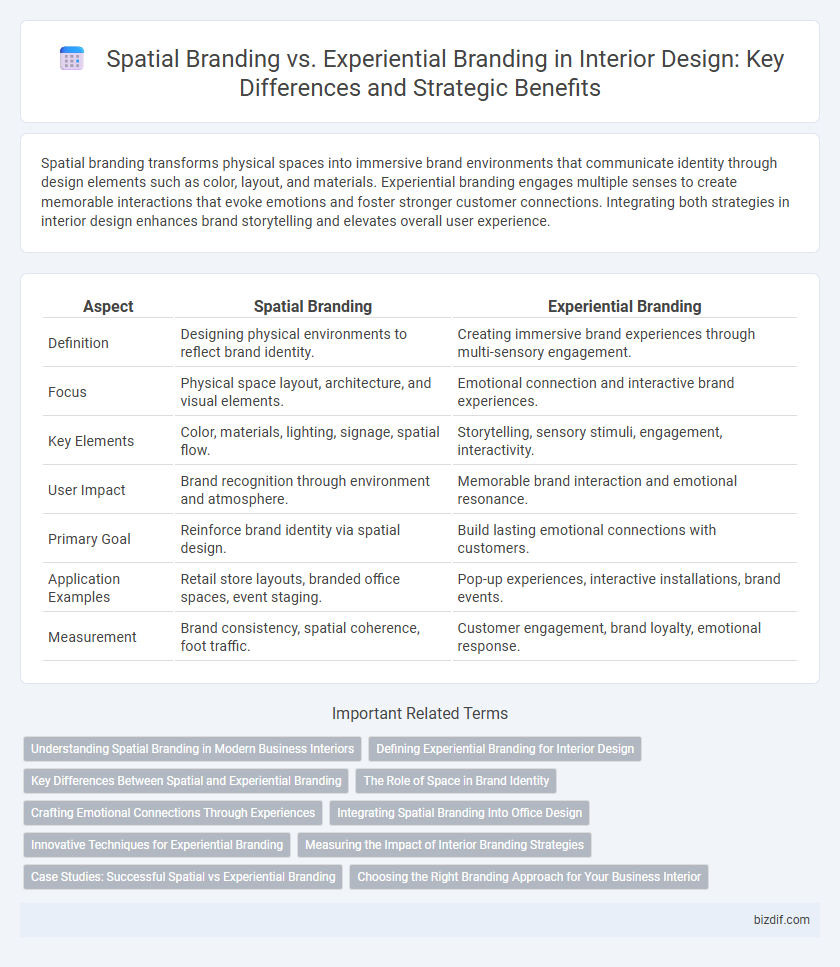Spatial branding transforms physical spaces into immersive brand environments that communicate identity through design elements such as color, layout, and materials. Experiential branding engages multiple senses to create memorable interactions that evoke emotions and foster stronger customer connections. Integrating both strategies in interior design enhances brand storytelling and elevates overall user experience.
Table of Comparison
| Aspect | Spatial Branding | Experiential Branding |
|---|---|---|
| Definition | Designing physical environments to reflect brand identity. | Creating immersive brand experiences through multi-sensory engagement. |
| Focus | Physical space layout, architecture, and visual elements. | Emotional connection and interactive brand experiences. |
| Key Elements | Color, materials, lighting, signage, spatial flow. | Storytelling, sensory stimuli, engagement, interactivity. |
| User Impact | Brand recognition through environment and atmosphere. | Memorable brand interaction and emotional resonance. |
| Primary Goal | Reinforce brand identity via spatial design. | Build lasting emotional connections with customers. |
| Application Examples | Retail store layouts, branded office spaces, event staging. | Pop-up experiences, interactive installations, brand events. |
| Measurement | Brand consistency, spatial coherence, foot traffic. | Customer engagement, brand loyalty, emotional response. |
Understanding Spatial Branding in Modern Business Interiors
Spatial branding in modern business interiors strategically integrates brand identity into physical environments, enhancing customer engagement through design elements like layout, color schemes, and signage. This approach transforms spaces into immersive brand experiences, reinforcing corporate values and improving brand recall. Unlike experiential branding, which includes multisensory customer interactions, spatial branding primarily focuses on the physical location as a medium for brand communication.
Defining Experiential Branding for Interior Design
Experiential branding in interior design creates immersive environments that engage all senses, fostering emotional connections between the brand and its audience. It integrates elements like lighting, textures, and spatial layout to convey the brand's story and values, transforming physical spaces into narrative experiences. This approach enhances brand recall and customer loyalty by making each interaction within the space meaningful and memorable.
Key Differences Between Spatial and Experiential Branding
Spatial branding emphasizes the physical environment and architectural elements to convey brand identity, using layout, lighting, and material choices to shape customer perception. Experiential branding focuses on creating immersive, interactive experiences that engage multiple senses and evoke emotional connections through storytelling and user participation. Key differences include spatial branding's static reliance on design elements versus experiential branding's dynamic engagement strategies that foster deeper brand loyalty.
The Role of Space in Brand Identity
Spatial branding integrates physical environment elements to communicate brand identity, shaping customer perception through layout, color schemes, and sensory design. Experiential branding emphasizes immersive interactions that engage emotions and create memorable brand experiences within the space. The role of space in brand identity is crucial, as it transforms abstract brand values into tangible, spatial narratives that influence consumer behavior and loyalty.
Crafting Emotional Connections Through Experiences
Spatial branding integrates physical environments with brand identity to evoke emotional responses and foster deep connections with consumers. Experiential branding emphasizes immersive, multi-sensory experiences that engage customers beyond visual aesthetics, creating memorable interactions. Both approaches leverage emotional storytelling to strengthen brand loyalty and transform spaces into powerful brand narratives.
Integrating Spatial Branding Into Office Design
Integrating spatial branding into office design enhances employee engagement by embedding brand elements within the physical environment, such as custom wall graphics, branded meeting rooms, and signature color schemes. This approach transforms workspaces into immersive brand experiences, reinforcing corporate identity and culture while boosting collaboration and productivity. Spatial branding in offices creates a cohesive environment that supports both functional needs and emotional connections to the brand.
Innovative Techniques for Experiential Branding
Innovative techniques for experiential branding in interior design leverage immersive technologies such as augmented reality, interactive installations, and multi-sensory environments to create compelling brand experiences. Spatial branding emphasizes the physical organization and aesthetic of a space, while experiential branding focuses on engaging consumers through dynamic interactions that evoke emotional connections. Incorporating personalized digital interfaces and responsive lighting systems enhances the experiential brand journey, driving deeper customer engagement and loyalty.
Measuring the Impact of Interior Branding Strategies
Measuring the impact of spatial branding involves quantifying customer engagement and brand recognition within physical environments through metrics such as foot traffic, dwell time, and sales conversion rates. Experiential branding effectiveness is assessed by tracking emotional responses, social media interactions, and customer loyalty influenced by immersive and multisensory interior design elements. Both strategies rely on data analytics, including customer feedback and behavior analysis, to optimize the spatial layout and sensory experiences that reinforce brand identity.
Case Studies: Successful Spatial vs Experiential Branding
Apple's flagship stores exemplify successful spatial branding by integrating minimalist design and product-centric layouts that reinforce the brand's identity and innovation ethos. Nike's House of Innovation showcases experiential branding through interactive zones and immersive digital experiences that engage customers on a sensory level. Both approaches demonstrate how physical environments can strategically enhance brand perception and customer loyalty.
Choosing the Right Branding Approach for Your Business Interior
Spatial branding emphasizes the strategic use of physical space, layout, and design elements to communicate brand identity within an interior environment. Experiential branding focuses on creating immersive, sensory-rich experiences that engage customers emotionally and foster brand loyalty. Selecting the right approach requires analyzing your business goals, target audience, and the desired level of interaction to effectively align your interior design with your brand message.
Spatial branding vs Experiential branding Infographic

 bizdif.com
bizdif.com